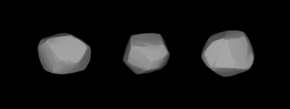 A three-dimensional model of 34 Circe based on its light curve | |
| Discovery | |
|---|---|
| Discovered by | J. Chacornac |
| Discovery date | April 6, 1855 |
| Designations | |
Designation | (34) Circe |
| Pronunciation | /ˈsɜːrsiː/[1] |
Named after | Circe |
| 1965 JL | |
| Main belt | |
| Adjectives | Circean /sərˈsiːən/[2] |
| Orbital characteristics[3] | |
| Epoch November 4, 2013 (JD 2456600.5) | |
| Aphelion | 2.967739 AU |
| Perihelion | 2.406230 AU |
| 2.686984 AU | |
| Eccentricity | 0.1045 |
| 4.40 a (1607.332 d) | |
Average orbital speed | 18.12 km/s |
| 39.80474° | |
| Inclination | 5.498° |
| 184.44157° | |
| 330.2330° | |
| Physical characteristics | |
| Dimensions | 113.02 ± 4.90 km[4] |
| Mass | (3.66 ± 0.03) × 1018 kg[4] |
Mean density | 4.83 ± 0.63 g/cm3[4] |
| ~0.0317 m/s² | |
| ~0.0600 km/s | |
| 0.5063 d (12.15 h) [3] | |
| Albedo | 0.0541 [3] |
| Temperature | ~172 K |
Spectral type | C |
| 8.51 | |
34 Circe is a large, very dark main-belt asteroid. It was discovered by French astronomer J. Chacornac on April 6, 1855, and named after Circe, the bewitching queen of Aeaea island in Greek mythology.
The spectrum of this object matches a C-type asteroid, suggesting a carbonaceous composition. It has a cross-section size of 113 km and is orbiting the Sun with a period of 4.40 years. Photometric observations of this asteroid made during 2007 at the Organ Mesa Observatory in Las Cruces, New Mexico gave an asymmetrical bimodal light curve with a period of 12.176 ± 0.002 hours and a brightness variation of 0.17 ± 0.02 in magnitude.[5] The spectra of the asteroid displays evidence of aqueous alteration.[6]
- ^ "Circe". Lexico UK English Dictionary. Oxford University Press. Archived from the original on 22 March 2020.
- ^ "Circean". Oxford English Dictionary (Online ed.). Oxford University Press. (Subscription or participating institution membership required.)
- ^ a b c Cite error: The named reference
JPLwas invoked but never defined (see the help page). - ^ a b c Cite error: The named reference
Carry2012was invoked but never defined (see the help page). - ^ Cite error: The named reference
Pilcher2008was invoked but never defined (see the help page). - ^ Cite error: The named reference
Fornasier1999was invoked but never defined (see the help page).